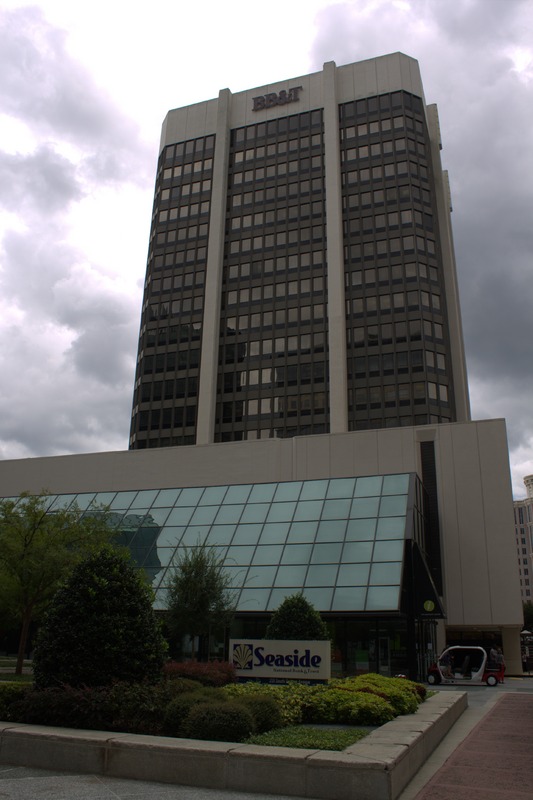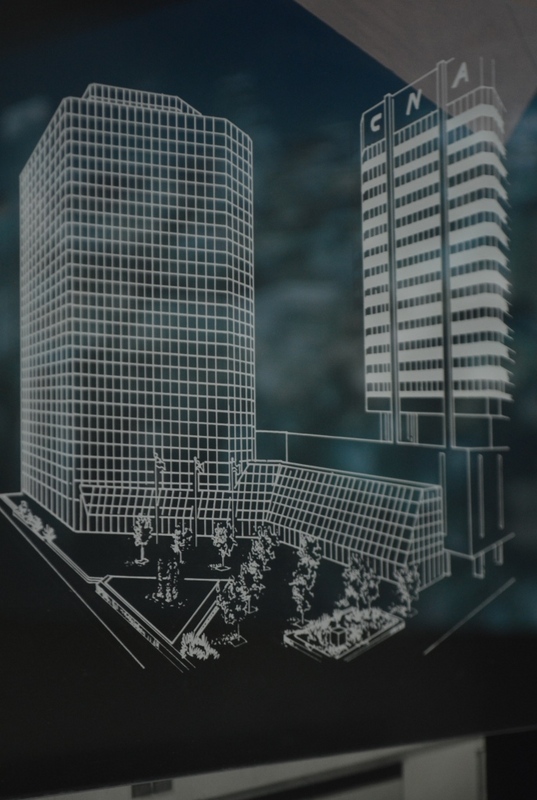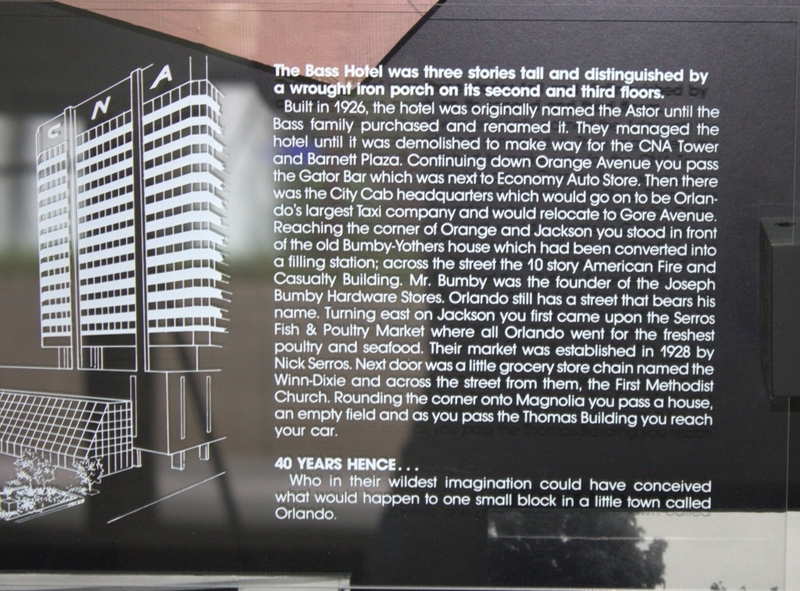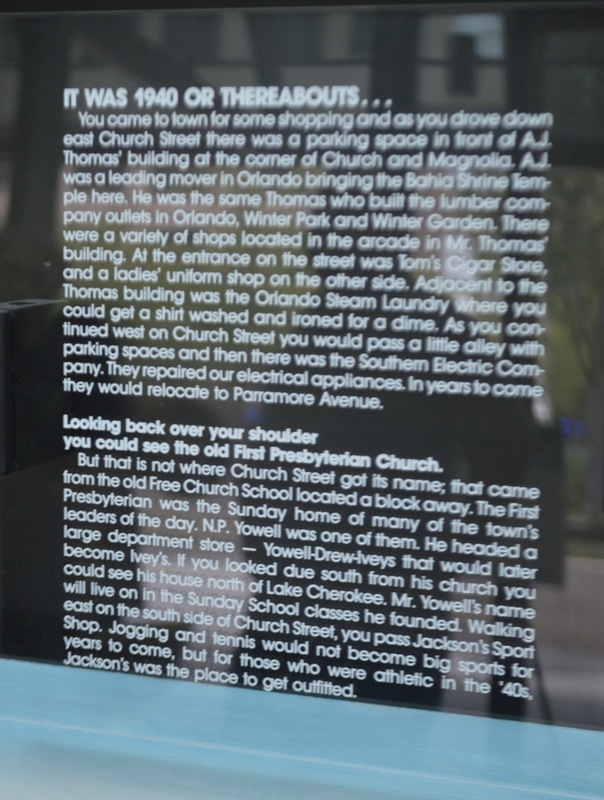Exhibit
The Orlando Remembered Exhibit is housed in Downtown Orlando Visitor Center, located at 201 South Orange Avenue, Orlando, Florida.
The Bass Hotel was three stories tall and distinguished by a wrought iron porch on its second and third floors.
Built in 1926, the hotel was originally named the Astor Hotel, until the Bass family purchased and renamed it. They managed the hotel until it was demolished to make way for the CNA Tower and Barrett Plaza. Continuing down Orange Avenue, you pass the Gator Bar, which was next to Economy Auto Store. Then there was the City Cab Company headquarters, which would go on to be Orlando’s largest taxi company and would relocate to Gore Avenue.
Reaching the corner of Orange and Jackson, you stood in front of the old Bumby-Yothers House, which had been converted into a filling station. Across the street was the 10-story American Fire and Casualty building. Joseph Bumby was the founder of the Bumby hardware stores. Orlando still has a street that bears his name. Turning east on Jackson, you first come upon the Serros’ Fish and Poultry Market, where all Orlando went for the freshest poultry and seafood. The market was established in 1928 by Nick Serros. Next door was a little grocery store named Winn-Dixie, and across the street from them was the First Methodist Church of Orlando. Rounding the corner onto Magnolia, you pass a house, an empty field, and, as you pass Thomas Building, you reach your car.
Forty years hence, who in their wildest imagination could have conceived what would happen to one small block in a little town called Orlando.
Then there was the Brass Rail, a poor man’s Berger’s Tavern.
There were some who say the draft beer of the Brass Rail was the best in town. The pickled eggs and hot sausage weren’t bas either. Adjoining the Brass Rail was Carolina Court, a kind of alley that was L-shaped that connected Orange Avenue to Church Street. In the court were all kinds of interesting little shops. One of the principal occupants was the Fems Printing Company, founded by Josiah Fems. Next to the Brass Rail was the American Dry Cleaners where you could get a suit cleaned and pressed for 75 cents. Trousers were a quarter. Then you come to Chamberlain’s Natural Foods (who would have thought health food would be so popular). Then there was Menendez Spanish Restaurant, often the scene of many social gatherings. It was the first of its kind in Orlando and undoubtedly one of the finest Hispanic eateries of all time. Next, we pass Foster’s Quality Foods, located in the Wilmot Building, which was erected in 1925. For many years, Phil Berger (the same one) had a fine men’s shop there, but in 1940, the principle tenant was Irwin Fox, a pleasant and friendly shoe merchant. Rounding the corner from East Church Street, you were on Orange Avenue and, if so inclined, you could get a haircut for 25 cents at the Star Barber Shop. Of course, you couldn’t forget to tip Max Yacobian. He kept generations of Orlandoans well-groomed. Strolling past the plate glass window of Keene & Keene optometrists, you couldn’t resist checking yourself out. And then, Ferrell’s Jewelry was always fun to window shop. Satisfied or not, you could always stop into the little bar in the Bass Hotel for a cold bottle of Jax beer.
It was 1940 or thereabouts. You came to town for some shopping and as you drove down East Church Street, there was a parking space in front of A. J. Thomas Building at the corner of Church and Magnolia. A. J. was a leading mover in Orlando bringing the Bahia Shrine Temple here. He was the same Thomas who built lumber company outlets in Orlando, Winter Park, and Winter Garden. There were a variety of shops located in the arcade in the Thomas Building. At the entrance on the street was Tom’s Cigar Store, and a ladies uniform shop on the other side. Adjacent to the Thomas Building was the Orlando Steam Laundry, where you could get a shirt washed and ironed for a dime. As you continued west on Church Street, you would pass a little alley with parking spaces and then there was the Southern Electric Company. They repaired out electrical appliances. In years to come, they would relocate to Parramore Avenue.
Looking back over your shoulder, you could see the old First Presbyterian Church of Orlando. But that is not where Church Street got its name; that came from the old Free Church School located a block away. The First Presbyterian was the Sunday home of many of the town’s leaders of the day, N. P. Yowell was one of them. He headed a large department store- Yowell-Drew-Ivey’s, which would later become Ivey’s.
If you looked due south from his church, you could see his house north of Lake Cherokee. Yowell’s name will live on in the Sunday school classes he founded. Walking east on the south side of Church Street, you pass Jackson’s Sport Shop. Jogging and tennis would not become big sports for years to come, but for those who were athletic in the 40s, Jackson’s was the place to get outfitted.
This glass etching is of Barnett Plaza that would occupy the square in later years.



